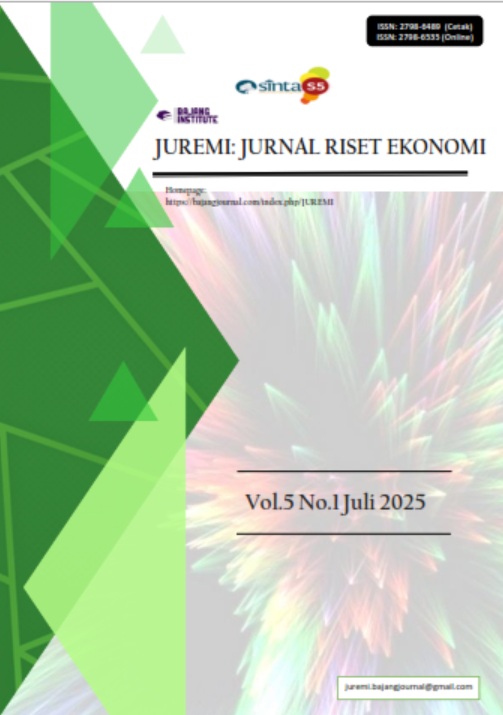INOVASI DALAM PELAYANAN PUBLIK DI DESA MONTONG GAMANG KECAMATAN KOPANG KABUPATEN LOMBOK TENGAH
DOI:
https://doi.org/10.53625/juremi.v5i1.11275Keywords:
Digital Village, Bureaucratic Effectiveness, Technological Innovation, Public ServiceAbstract
This study aims to analyze the influence of technology-based innovation on bureaucratic effectiveness in Montong Gamang Village, Kopang District, Central Lombok Regency. The method used is descriptive qualitative with a case study approach. Data were obtained through in-depth interviews, observations, and document analysis. The results show that technological innovations, such as the Village Information System (SID) and online service applications, improve the efficiency, transparency, and accountability of public services. Despite their positive impact, the implementation of innovations faces obstacles such as limited infrastructure, low digital literacy, and resistance to change. This study recommends strengthening infrastructure, ongoing training, and increasing community involvement to support the absence of innovation. These findings contribute to the development of literature related to public service innovation at the village level.
References
Bertot, J. C., Jaeger, P. T., & Grimes, J. M. (2010). The Politics of Online Government Transparency. The Information Society, 26(1), 56-68.
Bertot, J. C., Jaeger, P. T., & Grimes, J. M. (2010). Using ICTs to create a culture of transparency: E-government and social media as openness and anti-corruption tools for societies. Government Information Quarterly, 27(3), 264-271.
Bowen, G. A. (2009). Document analysis as a qualitative research method. Qualitative Research Journal, 9(2), 27-40.
Braun, V., & Clarke, V. (2006). Using thematic analysis in psychology. Qualitative Research in Psychology, 3(2), 77-101.
Creswell, J. W. (2018). Research Design: Qualitative, Quantitative, and Mixed Methods Approaches. Sage Publications.
Denhardt, J. V., & Denhardt, R. B. (2015). The New Public Service: Serving, Not Steering. Routledge.
Denzin, N. K. (1978). The Research Act: A Theoretical Introduction to Sociological Methods. McGraw-Hill.
Fang, Z. (2002). E-Government in Digital Era: Concept, Practice, and Development. International Journal of The Computer, The Internet and Management, 10(2), 1-22.
Fang, Z., & Wei, L. (2013). E-Government Implementation and the Impacts on Public Administration and Service Delivery. Springer.
Field, A. (2018). Discovering Statistics Using IBM SPSS Statistics. Sage Publications.
Grindle, M. S. (2007). Good Enough Governance Revisited. Development Policy Review, 25(5), 553-574.
KemenPAN-RB. (2021). Kompetisi Inovasi Pelayanan Publik 2021. Jakarta: Kementerian Pendayagunaan Aparatur Negara dan Reformasi Birokrasi.
Kementerian Desa. (2021). Program Smart Village: Inovasi Digital untuk Desa. Jakarta: Kementerian Desa, Pembangunan Daerah Tertinggal, dan Transmigrasi.
Kementerian Perencanaan Pembangunan Nasional. (2020). Rencana Pembangunan Jangka Menengah Nasional (RPJMN) 2020-2024. Jakarta: Kementerian PPN/Bappenas.
Lind, M., Wæraas, A., & Dahlström, C. (2020). Government Digitalization and Its Effects on Public Sector Performance: A Study of Local Governments in Sweden. Public Management Review, 22(7), 1042-1062.
Mardiyono, H., & Susanti, S. (2020). Implementasi Sistem Informasi Desa untuk Peningkatan Transparansi dan Efisiensi Pelayanan Publik di Kabupaten Bantul. Jurnal Kebijakan Publik, 12(3), 45-59.
Mergel, I. (2018). Digital Transformation in the Public Sector: The Implementation of Digital Services in Government Agencies. Public Administration Review, 78(2), 173-182.
Merriam, S. B. (2009). Qualitative Research: A Guide to Design and Implementation. Jossey-Bass.
Miles, M. B., Huberman, A. M., & Saldaña, J. (2014). Qualitative Data Analysis: A Methods Sourcebook. Sage Publications.
Mulgan, R. (2000). Accountability: An Ever-Expanding Concept?. Public Administration, 78(3), 555-573.
Mulgan, G., & Albury, D. (2003). Innovation in the Public Sector. Cabinet Office Strategy Unit.
Neuman, W. L. (2014). Social Research Methods: Qualitative and Quantitative Approaches. Pearson Education.
Osborne, S. P., & Brown, K. (2011). Handbook of Innovation in Public Services. Edward Elgar Publishing.
Osborne, D., & Gaebler, T. (1992). Reinventing Government: How the Entrepreneurial Spirit is Transforming the Public Sector. Addison-Wesley.
Patton, M. Q. (2015). Qualitative Research and Evaluation Methods. Sage Publications.
Prasojo, E., Kurniawan, T., & Holidin, D. (2017). Reformasi Birokrasi Desa: Mewujudkan Tata Kelola Pemerintahan Desa yang Efektif dan Akuntabel. Jakarta: Gramedia.
Rahardjo, M., & Wijayanti, A. (2019). Digitalisasi pelayanan publik di tingkat desa: Peluang dan tantangan. Jurnal Ilmu Administrasi Publik, 8(2), 45-60.
Robbins, S. P., & Coulter, M. (2018). Management. Pearson.
Stake, R. E. (1995). The Art of Case Study Research. Sage Publications.
Widodo, J. (2020). Pelayanan Publik Berbasis Teknologi di Era Digital. Jurnal Kebijakan dan Manajemen Publik, 9(1), 1-15.
United Nations. (2018). E-Government Survey 2018: Gearing E-Government to Support Transformation towards Sustainable and Resilient Societies. United Nations, Department of Economic and Social Affairs.
Yin, R. K. (2018). Case Study Research and Applications: Design and Methods. Sage Publications.
Zaucha, J., & Török, J. (2020). Public service design for sustainable development in rural areas. Sustainability, 12(15), 6055.
















